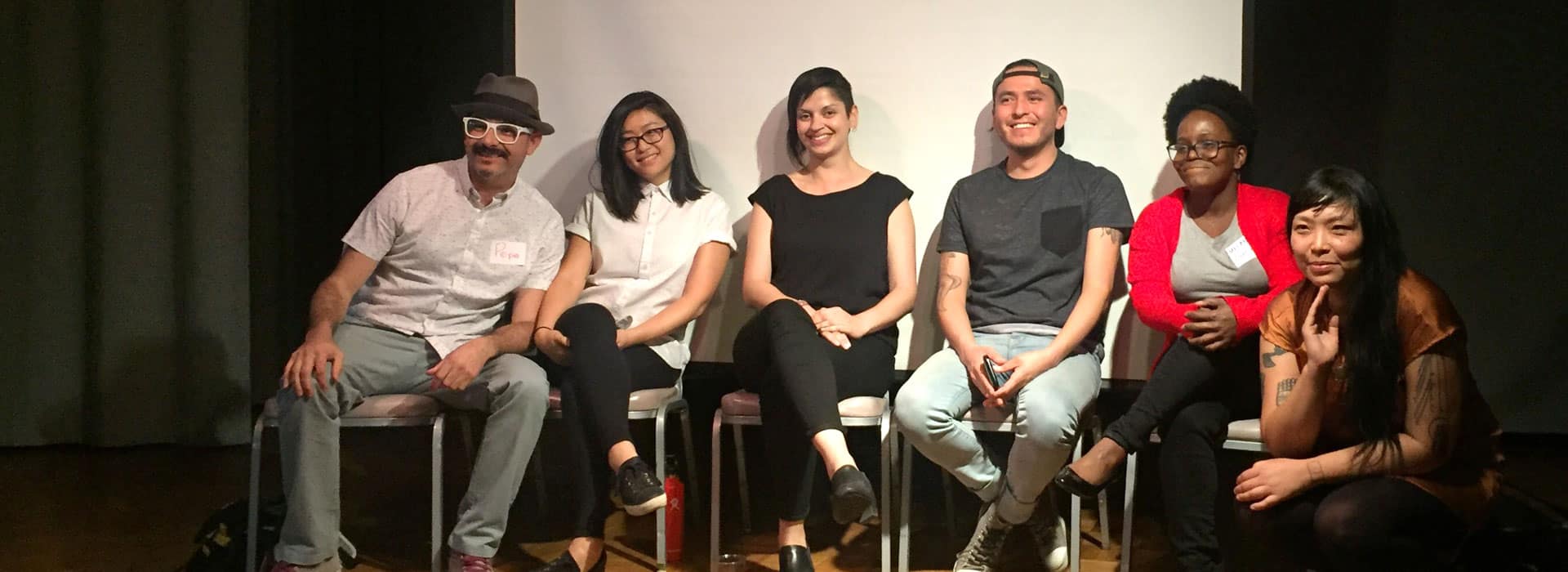by Humberto Marquez Mendez
Code-Switching, the practice of alternating between different languages, ways of speaking, conduct, and presentation of self, is often the reality for people of color and other marginalized groups. From a young age, we learn from our community, personal experiences, and observations that “acting” a certain way results in access to resources or success, while behaving in other ways results in barriers or rejection. Accepted patterns of behavior generally fall under white dominant culture, while less accepted behavior falls outside of white dominant culture. Code-switching has become a survival mechanism for people of color in a system created by and for white people to succeed.
We explored this practice of code-switching to navigate the art world in our April Art & Power conversation with 5 panelists, including Demian DinéYazhi´, Jenny Chu, Melanie Stevens, Pepe Moscoso, and Roshani Thakore – led by returning facilitator, Anna Vo. While common practice, the panelists unanimously agreed that code-switching is constant, emotionally exhausting, and plays into respectability politics, where you have to ‘play the game’ and follow the rules of those in power to survive and succeed.
Throughout the discussion artists shared experiences of debating or strategizing how to act in order to navigate systems and situations, particularly in response to the tokenization, exploitation, and fetishization of their art by predominantly white institutions. Early into the panel, Jenny stated, white people don’t ever not have to be white. People of color on the other hand, have to learn how to go into a room and not be a person of color. How their art is seen, judged, and supported is colored by their identity, including their race and ethnicity.
Do you participate in institutions that tokenize artists of color? Do you change your art to “fit in” with institutions’ expectations, or do you challenge them, knowing it may cost you opportunities? Traditional arts institutions have, whether intentionally or not, developed and codified expectations of artists of color’s work based on stereotypes and fetishization – how do you challenge that if you want to work within the institution? Do you? How do you exist as an artist of color – as the way you are, and succeed within institutions that only see artists of color in one-dimensional ways? How do you create art based on your own experience and perspective when institutions are telling you that’s not what they want?
These questions are only a few that artists of color ask, yet illuminate the constant tension felt by artists of color in social systems and institutions that center whiteness and white art. An example Demian offered highlights this tension: when invited to show a piece at a prominent museum, he debated whether or not to accept the offer and work with an institution that had a problematic history with communities of color. If he declined, would there be another indigenous artist represented in the exhibition? He ultimately decided to accept the offer while finding ways to challenge it from within. For Demian, accepting the offer meant increasing indigenous visibility, reclamation of space, and using the platform to highlight another indigenous artist. In his words, “If I don’t represent, who will?
The scarcity model many institutions operate under exacerbates this tension. The idea that there aren’t enough resources for everyone permeates and shows up in the arts world through things like invite-only exhibitions, grants, open calls, etc. We also see this in the form of caps or limits to the number of artists of color represented in a show – the unspoken diversity quota.
Back to Demian’s example, he challenged the institution’s scarcity model by collaborating with another indigenous artist to show there is space for everyone, especially those most often shut out. This is a reminder that institutions hold the power and responsibility to move beyond the scarcity model, offer flexibility in processes, and check for bias and barriers that force artists of color to code-switch.
As we always ask: What is RACC doing to challenge these structures? One action RACC has taken is to re-evaluate our artist selection and granting processes by gathering feedback from past and current grantees and artists and changing them based on the feedback. We reviewed panelist processes, selection criteria, and fund distribution to better identify and remove barriers that unfairly burden artists of color.
So what can arts institutions do to challenge the systems and structure? Learn, support, deconstruct, and rebuild. Go through trainings and learning circles with all staff, board, and volunteers. Find and support the ongoing efforts led by artists of color. Challenge your organization’s “business as usual”, and map out what deconstructing a flawed system and building an equitable one looks like. Things will not change unless we all do our part, and arts institutions, as gatekeepers, funders, exhibitors, trend setters, have a very big part to play.
As we continue on our journey, here are a few resources or examples to check out:
- Read Jenny Chu’s article “Race and reading: The white echo chamber.”
- PICA’s Precipice Fund supports projects that operate outside of traditional forms of support, galvanize communities, and are often anti-institutional, innovative, and intentionally nebulous.
- APANO’s Arts and Media Project challenges institutions and culture to reflect the diversity in the Asian American and Pacific Islander identity.
- Ori Gallery is led by and for artists of color to “reclaim and redefine ’the white cube’” by amplifying voices of Trans and Queer Artists of color, community organizing, and mobilization through the arts.”
- R.I.S.E. (Radical Indigenous Sovereign Empowerment) is dedicated to supporting two-spirit/gender gradient/non-binary indigenous artists.
Join us for our third Art & Power event as we explore the power of art and creative expression as tools for healing, survival and empowerment. June 20, 6 – 8:30pm at Teatro Milagro – El Zócalo. Full event details and registration link are here

